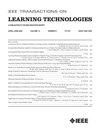基于 ChatGPT 的学习平台,用于创建不同攻击模型签名和开发网络攻击检测防御算法
IF 4.9
3区 教育学
Q2 COMPUTER SCIENCE, INTERDISCIPLINARY APPLICATIONS
引用次数: 0
摘要
云技术在流程、制造、医疗保健和金融等工业领域的应用正在稳步上升,但随着云技术的发展,有针对性的网络攻击的风险也在增加。因此,要有效抵御此类攻击,就必须有技术娴熟的网络安全专业人员。传统的以人为基础的网络物理教育需要大量资源,在与快速发展的技术保持同步方面面临挑战。本研究重点关注将大型语言模型纳入网络物理教育的主要优势。ChatGPT 平台是一个在线工具,用于向学生传授基础知识、网络攻击和防御概念,培养新一代网络安全专家。拟议的学习方法采用 ChatGPT 辅助学习-应用-创建模式。根据学习者提供的提示,学习阶段进行概念学习,应用阶段建立各种网络攻击的数学模型,创建阶段开发 MATLAB 程序,将攻击纳入实验的传感器测量中,并开发必要的攻击检测方法。在模拟和实时场景中,使用 J 型热电偶评估了 ChatGPT 开发的检测方法的有效性。通过对学习者的基础概念、计算思维、编程效率和学习动机进行广泛的比较反馈分析,评估了所提出的学习平台对传统学习方法的影响。研究证明,将 ChatGPT 融入工程教育能让学生快速学习网络物理基础知识,理解网络攻击并建立模型,创建新的攻击特征,并为开发检测算法做出贡献。这种整合为学习者提供了对现代工业至关重要的基本工业技能。本文章由计算机程序翻译,如有差异,请以英文原文为准。
ChatGPT-Based Learning Platform for Creation of Different Attack Model Signatures and Development of Defense Algorithm for Cyberattack Detection
Cloud adoption in industrial sectors, such as process, manufacturing, health care, and finance, is steadily rising, but as it grows, the risk of targeted cyberattacks has increased. Hence, effectively defending against such attacks necessitates skilled cybersecurity professionals. Traditional human-based cyber-physical education is resource intensive and faces challenges in keeping pace with rapidly evolving technologies. This research focuses on the main advantages of incorporating large language models into cyber-physical education. The ChatGPT platform serves as an online tool to educate students on fundamentals, cyberattacks, and defense concepts, fostering the development of a new generation cybersecurity experts. The proposed learning approach adheres to the ChatGPT-assisted learn–apply–create model. Responding to prompts provided by the learners, the learning phase engages in conceptual learning, the applying phase involves mathematical modeling of various cyberattacks, and the creating phase develops MATLAB program to incorporate attacks into sensor measurements for the experiment and entails developing the necessary attack detection approaches. The effectiveness of the detection method developed by ChatGPT is assessed in both the simulation and real-time scenarios using a J-type thermocouple. The impact of the proposed learning platform over traditional learning methods is evaluated through an extensive comparative feedback analysis on the learner's foundational concepts, computational thinking, programming efficacy, and motivation. The study proved that integrating ChatGPT into engineering education enables students to swiftly learn cyber-physical fundamentals, comprehend and model cyberattacks, create new attack signatures, and contribute to developing detection algorithms. Such integration provides the learners with essential industrial skills crucial in modern industries.
求助全文
通过发布文献求助,成功后即可免费获取论文全文。
去求助
来源期刊

IEEE Transactions on Learning Technologies
COMPUTER SCIENCE, INTERDISCIPLINARY APPLICATIONS-
CiteScore
7.50
自引率
5.40%
发文量
82
审稿时长
>12 weeks
期刊介绍:
The IEEE Transactions on Learning Technologies covers all advances in learning technologies and their applications, including but not limited to the following topics: innovative online learning systems; intelligent tutors; educational games; simulation systems for education and training; collaborative learning tools; learning with mobile devices; wearable devices and interfaces for learning; personalized and adaptive learning systems; tools for formative and summative assessment; tools for learning analytics and educational data mining; ontologies for learning systems; standards and web services that support learning; authoring tools for learning materials; computer support for peer tutoring; learning via computer-mediated inquiry, field, and lab work; social learning techniques; social networks and infrastructures for learning and knowledge sharing; and creation and management of learning objects.
 求助内容:
求助内容: 应助结果提醒方式:
应助结果提醒方式:


